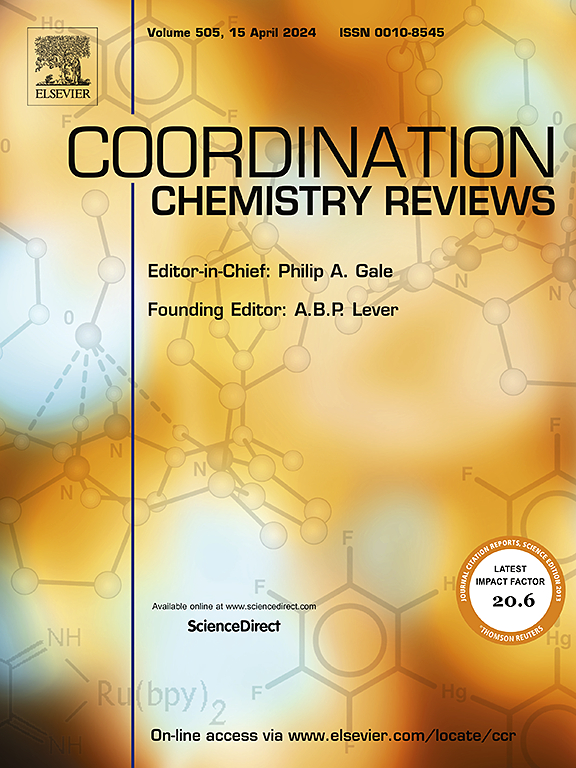Electron Magnetic Resonance (EMR) and related studies of transition metal (3dN) dopants in titanium dioxide (TiO2) systems: guide in tailoring the material's properties for specific technological applications
IF 20.3
1区 化学
Q1 CHEMISTRY, INORGANIC & NUCLEAR
引用次数: 0
Abstract
Doping the transition metal (TM) ions into TiO₂, both anatase and rutile forms, has garnered significant interest due to their impact on the structural, spectroscopic and magnetic properties of these materials. By different doping concentrations of specific TM ions, these key physical properties can be customized for specific applications in diverse areas such as catalysis, optoelectronics, spintronics, and metamaterials. Electron Magnetic Resonance (EMR) spectroscopy techniques are particularly powerful tools for investigating TM ions in coordination complexes. To lay the groundwork, we overview crystallography, synthesis, and spectroscopic techniques. The basics of spin Hamiltonian (SH) theory are recapped. This enables interpretation of EMR spectra and physical properties of TM ions in TiO₂ systems in terms of SH parameters. Experimental EMR-related studies of TM (3dN) ions in doped and undoped TiO₂ systems are comprehensively surveyed to identify key aspects and highlight important issues. Computational studies utilizing various approaches to model SH parameters and thus verify experimentally measured parameter values are also surveyed. This review signifies that integrating experimental techniques with modeling approaches enables a more profound understanding of the key physical properties. The systematic analysis of literature data and categorization of various aspects and issues may facilitate creation of innovative materials with customized properties for particular applications. This may encourage additional research to discover new capabilities of the TiO₂-based adaptable semiconductors.

电子磁共振(EMR)和二氧化钛(TiO2)体系中过渡金属(3dN)掺杂剂的相关研究:为特定技术应用量身定制材料特性的指南
将过渡金属(TM)离子掺杂到钛₂中,无论是锐钛矿还是金红石,由于它们对这些材料的结构、光谱和磁性能的影响,已经引起了人们的极大兴趣。通过不同浓度的特定TM离子掺杂,这些关键的物理性质可以定制为不同领域的特定应用,如催化、光电子、自旋电子学和超材料。电子磁共振(EMR)光谱技术是研究配合物中TM离子的有力工具。为了奠定基础,我们概述了晶体学,合成和光谱技术。回顾了自旋哈密顿(SH)理论的基础。这使得可以根据SH参数解释TiO₂系统中TM离子的EMR谱和物理性质。本文对TM (3dN)离子在掺杂和未掺杂tio2体系中的实验emr相关研究进行了全面调查,以确定关键方面并突出重要问题。计算研究利用各种方法来模拟SH参数,从而验证实验测量参数值也进行了调查。这一综述表明,将实验技术与建模方法相结合,可以更深刻地理解关键的物理性质。对文献数据的系统分析和对各个方面和问题的分类可能有助于为特定应用创造具有定制属性的创新材料。这可能会鼓励进一步的研究,以发现基于tio2的适应性半导体的新功能。
本文章由计算机程序翻译,如有差异,请以英文原文为准。
求助全文
约1分钟内获得全文
求助全文
来源期刊

Coordination Chemistry Reviews
化学-无机化学与核化学
CiteScore
34.30
自引率
5.30%
发文量
457
审稿时长
54 days
期刊介绍:
Coordination Chemistry Reviews offers rapid publication of review articles on current and significant topics in coordination chemistry, encompassing organometallic, supramolecular, theoretical, and bioinorganic chemistry. It also covers catalysis, materials chemistry, and metal-organic frameworks from a coordination chemistry perspective. Reviews summarize recent developments or discuss specific techniques, welcoming contributions from both established and emerging researchers.
The journal releases special issues on timely subjects, including those featuring contributions from specific regions or conferences. Occasional full-length book articles are also featured. Additionally, special volumes cover annual reviews of main group chemistry, transition metal group chemistry, and organometallic chemistry. These comprehensive reviews are vital resources for those engaged in coordination chemistry, further establishing Coordination Chemistry Reviews as a hub for insightful surveys in inorganic and physical inorganic chemistry.
 求助内容:
求助内容: 应助结果提醒方式:
应助结果提醒方式:


